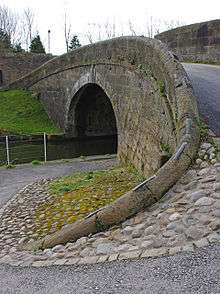Coping (architecture)

Coping (from cope, Latin capa) consists of the capping or covering of a wall.
A splayed or wedge coping slopes in a single direction; a saddle coping slopes to either side of a central high point.[1]
A coping may consist of stone (capstone), brick, tile, slate, metal, wood or thatch. In all cases it should be weathered to throw off the water.
Various types of copings exist. A diagramatic explanation of copper copings is available.[2][3][4]
In Romanesque work copings appeared plain and flat, and projected over the wall with a throating to form a drip. In later work a steep slope was given to the weathering (mainly on the outer side), and began at the top with an astragal; in the Decorated style there were two or three sets off; and in the later Perpendicular Period these assumed a wavy section, and the coping mouldings continued round the sides, as well as at top and bottom, mitreing at the angles, as in many of the colleges at Oxford.
References
 This article incorporates text from a publication now in the public domain: Chisholm, Hugh, ed. (1911). "article name needed". Encyclopædia Britannica (11th ed.). Cambridge University Press.
This article incorporates text from a publication now in the public domain: Chisholm, Hugh, ed. (1911). "article name needed". Encyclopædia Britannica (11th ed.). Cambridge University Press.
- ↑ Ching, Francis D. K. (1995). A Visual Dictionary of Architecture. Van Nostrand Reinhold Company. ISBN 0-442-02462-2, p. 266.
- ↑ Flashings and copings: Coping covers; http://www.copper.org/applications/architecture/arch_dhb/flashings_copings/coping_covers.html
- ↑ Flashings and coatings: Counterflashing; http://www.copper.org/applications/architecture/arch_dhb/flashings_copings/counterflashing.html
- ↑ Flashings and copings: Stepped and chimney flashings